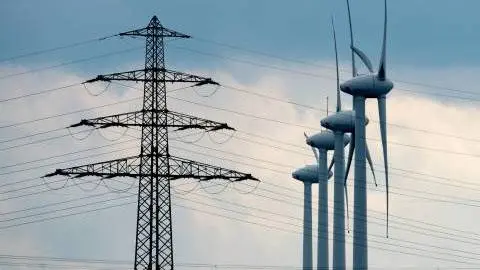European Utilities: Big investments and bigger debt
At the forefront of the energy transition, European utilities will invest c.€160bn to shift their electricity generation from fossil fuels to renewable energy as grids need to be modernised and expanded
The European Union aims to cut net greenhouse gas emissions by at least 55% by 2030, compared to 1990 levels, and achieve climate neutrality by mid-century. To support this, the EU is focusing on renewable energy, energy efficiency, and the resilience of clean energy supply chains, including manufacturing and critical minerals. In June 2024, the European Commission adopted the Net Zero Industry Act to enhance clean technology manufacturing, aiming to meet 40% of the EU’s deployment needs by 2030 and reduce dependency on energy.
Call 1: Capital expenditure guidance points to a 9% increase for the sector in 2025
According to their capital expenditure plan disclosures, the top 40 European utilities1 will invest a total of €160bn in 2025, representing a 9% growth rate versus 2024. Between 2019 and 2025, the top 40 European utilities will have doubled their investments.
1 Top 40 European utilities
Investment has significantly grown 2019-25F (€bn)

European integrated utilities, whose activities stretch from grid operations, power generation, supply and customer services, show investment amounts that look very significant. Altogether the top 20 European utilities2 will invest €108bn in 2025, an 8% increase vs. 2024. These utilities are usually large-scale enterprises offering their services on several continents. Among the biggest investors we could cite:
- Enel will spend more than €11bn in 2025. The Italian utility plans to invest around €210 billion between 2021 and 2030, including €40bn through third parties. Enel will focus on renewable energy, grid modernisation, and digitalisation. The company aims to have about 80% of its installed capacity from renewable sources by 2030.
- EDF’s capital expenditure should reach €22bn in 2025 with a 2030 strategic vision plan that includes an investment programme of €100bn for renewables and nuclear energy to ensure a low-carbon energy mix.
- Iberdrola has outlined a €150 billion investment plan in the period 2024-2030, with €12bn in 2025 alone. Iberdrola has a significant focus on offshore wind and solar projects. The Spanish utility aims to increase its renewable capacity between 2020 and 2030 from 35GW to 95GW.
- Engie wants to reach a total renewable capacity of 95GW by 2030. The French utility will invest another €10bn in 2025 and should maintain a similar investment level until 2030.
Looking at the top 20 European integrated utilities, about half of their investment will be dedicated to renewable energy while 30% will go to their network infrastructures. In comparison with 2018, utilities’ investments into renewables represented 33% and conventional power generation 39% of their capital expenditure.
2 Top 20 European integrated utilities: A2A, Acea, EnBW, Enel, Centrica, CEZ, EDF, Enel, Engie, E.ON, Fortum, Hera, Iberdrola, Orsted, RWE, Statkraft, Suez, Vattenfall, Veolia, Verbund
Half of integrated utilities’ capex dedicated to renewables in 2025

| +12% |
In capex for grid operators in 2025 |
If investment in the European utility sector grows by an average of 9% in 2025, our sub-segment representing the top 20 network utilities3 should grow by an average of 12% to €54bn. Grid operators will see the biggest capex expansion again. Germany and the Netherlands are the two countries that are the most concerned about spiralling investment needs. For too long, the sector in the two countries has relied on coal and natural gas, and the transition has required a faster rollout of wind and solar power. This also includes drastic efforts to upgrade and build new grids.
3 Top 20 European network utilities: Alliander, Amprion Elia, Enagas, Enexis, Eurogrid, Fluvius, Fluxys, Italgas, Fingrid, National Grid, Nederlandse Gasunie, Redeia, Redexis, REN, RTE, Stedin, Snam, TenneT, Terna
High investment in grids is a long-term theme
Between 2019 and 2025, the top 20 European grid operators will have almost tripled their yearly investments, from €19bn to €54bn. Taking into consideration all the players operating and developing gas and power infrastructure in Europe, BloombergNEF estimates total investments at €65bn in 2025 (the top 20 representing 83% of that amount). The information provider forecasts a long-term investment trend for grids and yearly capital expenditure of €95bn in 2030 and €157bn in 2040. While these amounts are huge, they are the amounts estimated to be necessary to accommodate the green energy coming online: offshore and onshore wind, solar, hydrogen, hydroelectric, geothermal and biomass.
Call 2: For grid operators, capex is overwhelming
Between 2020 and 2024, the debt burden of the top 40 European utilities has become heavier. By the end of 2020, we estimate the top 40 European utilities to have an aggregated €520bn in gross debt. By the third quarter of 2024 (or half-year 2024 for those reporting financials only twice a year), the gross debt burden of the group reached €890bn, a 70% increase within a five-year period. The expansion of the balance sheets can mostly be explained by the requirements imposed by the energy transition.
| +70% |
European utilities’ debt burden increased by 70% in the last five years |
While gross debt has increased at a higher rate for integrated utilities, network utilities continue to have a much higher proportion of debt compared to the cash flow they generate. At the end of 2024, our top 20 European integrated utilities reached an average gross debt to EBITDA metric of 4.6x. This ratio is 6.9x for pure network utilities, with some grid operators close to a ratio of 9x. The level of investment is good news for network utilities as it allows them to grow their regulated asset base and thus their remuneration. However, their financial situation raises questions about the current and future health of the balance sheet, especially knowing that investments need to triple by 2040 to reach the bloc’s net zero ambition.
Comparing EBITDA and capital expenditure for the sector, we expect the top 20 network utilities to reach an average capex-to-EBITDA ratio of 172% in 2025, meaning that more than 70% of capex funding cannot be made with organic cash flow generation. The ratio has gradually deteriorated since 2020 as the ambition for renewable energy has become stronger across Europe, pushing grid operators to upgrade and develop their networks.
For integrated utilities, the average capex-to-EBITDA ratio should reach 76% in 2025, indicating that capital expenditure alone can still be financed by cash flow generation.
Capex-to-EBITDA ratios for pure grid operators surge in 2019-25F

To fund the growing capital expenditure and dividend payments, European utilities have sought diverse solutions to meet their requirements. The bond and loan markets have been used extensively. Capital increases and shareholder loans are now also part of the solution to maintain credit metrics within boundaries.
| €75bn |
Utilities will issue a minimum of €75bn on the euro denominated bond market |
In 2018, Utilities issued a total of €24bn of bonds on the euro market. In 2021, the amount was €57bn and we expect a minimum of €75bn in 2025. On the bond market, hybrid bonds (with rating agencies classifying 50% of the amount as debt and 50% as equity) have flourished over the years, also as a tool to keep debt ratios within the minimum requirements of the ascribed credit ratings.
European utilities: bond issuance grows significantly 2018-25F (€bn)

Call 3: Capital increases and shareholder loans to the rescue
For years, European utilities have sold shares to fund their acquisitions in diverse markets. The capital increases of today reflect the need to gather funds to support the transition to sustainable energy systems. To cite a few, Enel, Iberdrola, EDF and RWE have all raised billions of euros in the last five years to finance the development of renewables or acquisitions to expand their activities in the green energy fields.
Traditionally the preserve of integrated utilities, pure network operators now also need to raise capital
Because of their size, their extended value chain and their presence on stock markets, integrated utilities have been able to raise new capital. For network operators, especially those not listed on stock markets, access to equity capital is a more difficult topic. But with skyrocketing investment needs, pure network operators now also need to raise capital.
National Grid rose £7bn in 2024 on the stock market. The Elia Group rose €600m, financed by its two main shareholders 80% by Publi-T and 20% KfW bank). It was not Elia’s first capital increase as the Belgian and German network operator has received new equity several times since 2015.
Shareholders may prefer to provide funding in the form of shareholder loans which allow them to apply a fixed return through a defined coupon on debt. It also gives them the option of seeing their capital returned when the loan matures.
After its failed negotiations with the German state to dispose of TenneT Germany, the Dutch government has been obliged to provide TenneT with loan facilities for the continuation of the utility’s investment plan. The Dutch state also has an agreement with the Dutch electricity and gas distribution players for equity injection or loans if necessary.
European utilities, both integrated and pure networks, will need to continue raising capital or benefit from shareholder loans to access funding. We expect new announcements in 2025. Without these actions, the deterioration of the players’ balance sheet would lead to a further deterioration in credit metrics, and credit rating downgrades. After the quasi-bankruptcy of Thames Water and the difficulties of the UK Water sector in general, concerns could turn to the EU electricity network companies with investment levels that look less and less sustainable.
This publication has been prepared by ING solely for information purposes irrespective of a particular user's means, financial situation or investment objectives. The information does not constitute investment recommendation, and nor is it investment, legal or tax advice or an offer or solicitation to purchase or sell any financial instrument. Read more
Download
Download article
22 January 2025
Energy Outlook 2025: Growth amid challenges This bundle contains 7 Articles